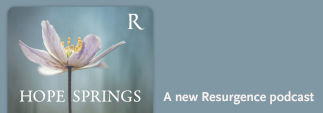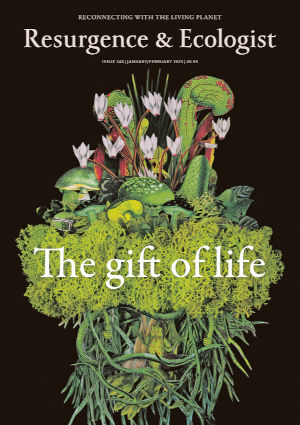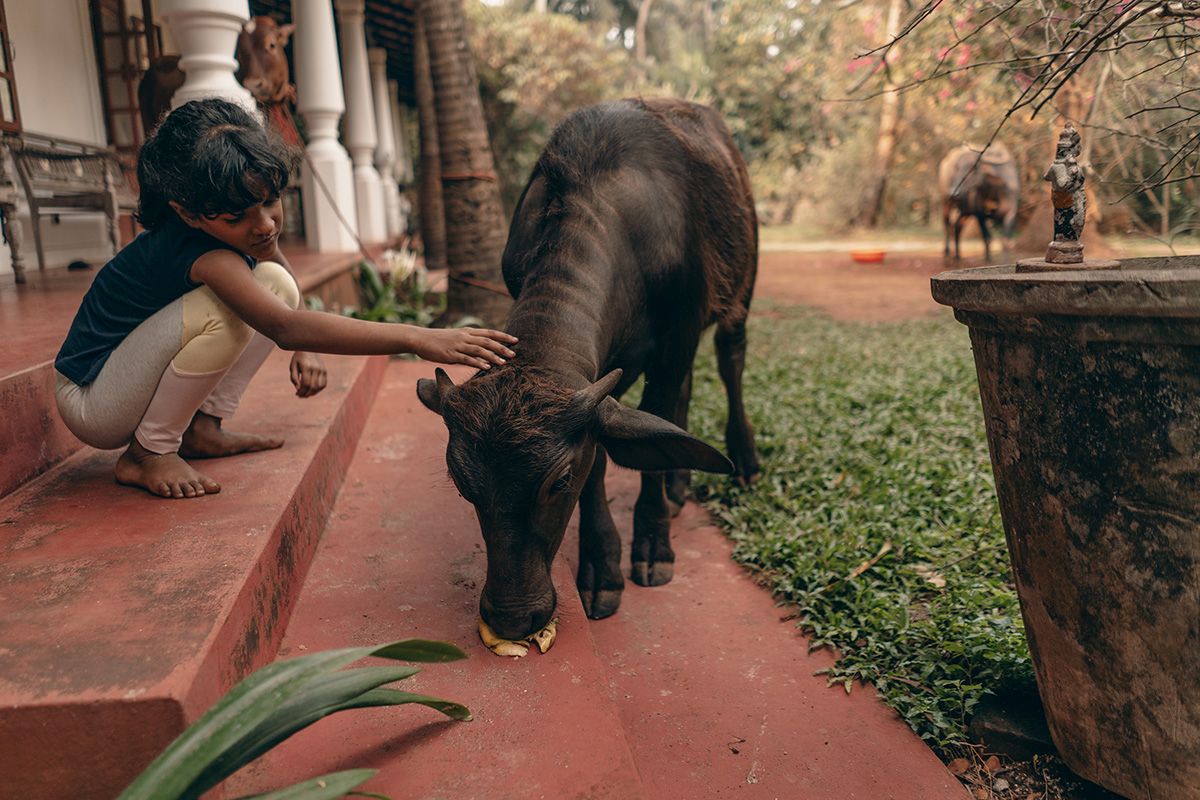For twenty-one straight days and nights, monsoon pours down on our Goan village. Torrential rainfall drums on our home, onto the coconut paddy fields, and uproots old mangroves. Every so often, the incessant rain beat is interrupted by the gusts coming off the Indian Ocean or by the roar of thunder that rumbles into our bones. Just when it seems like the rain can’t come down any harder, the intensity rises.
In the midst of the monsoon descent, our two-tonne water buffalo rescue, Lakshman (the love of our life) has an open wound on his hoof. As he needs a regular application of maggot prevention medicine, I wade through knee-deep water and dredge my feet through the red mud to get close to him. I then make my way to our littlest cow, Sita, who needs breakfast hand-fed. My last stop is our yoga shala (yoga house). An aged mango tree that stands by the Tulsi (Holy Basil) shrine and homes our native birds, squirrels and insects has collapsed from water retention, and a plan for its removal needs to be put into place.
During ‘the season’ in Goa, when Nature hums a melodious tune with magenta-hued sunsets, one would never imagine the adversities that the extreme summer heat and monsoon storms brings to our surroundings. When the sun scorches the land and dries up our wells, or the rains swoop in right after, pounding through our clay-tiled roof and flooding our walkways for days, the idea of leaving seems reasonable. However, a voice deep inside says: stay.
It is through staying in one place all year round that the pace of each season is understood, crafting how we develop stamina as a family and work with our ancestral soil. We dedicate our spring to rejuvenating one of my grandmother’s forgotten wells, and our summer raising grounds, sun-drying our coconuts for oil, and baking our dung. We learn to pare down to only what is absolutely necessary in the heavy rains. We observe how our indigenous trees thrive in the water, and some flowering plants bloom their fullest in the grey. While our cows prefer to cuddle under the overhang of the gaushala (cow shelter), our water buffalos smile as they roll around outside in the voluminous puddles. They show us that some of the grounds should by no means be raised.
When I first started to practise yoga as a young girl in the 1970s, the simple act of following my breath in a quiet, unbroken manner marked the beginning of a shift in the course of my life. The path was not immediate, or overt, and it didn’t follow a straight line – instead being subtle, deep-seated and winding. The step-by-step method of self-study that defines the journey led to spaces of vast silence, to a solitude, touching upon an innate essence.
At the heart of cultivating awareness there has been a connection to calmness amidst the waves of living, especially in moments of turbulence and unknowns. Those experiences proved to be a gateway to peace and possibility. In some cases, they served as opportunities for resilience to start again, and in all cases, they were always a cause to continue along the yogic path.
The practice of yoga ignited an inner light to gently persist through a sacred geometry, ever aligning to the soul. At the same time, proceeding along this way taught courage and clarity to engage with the world through action and responsibility. A slow, consistent approach has been principal in applying knowledge drawn from the microcosm of spiritual discipline into the macrocosm of everyday life. Putting what has been experienced into the world is an essential aspect of living yoga, and it is in the application that the sense of union is felt.
The bridge from within to without proved especially firm when sublimating the ego to the wisdom of the body. This wisdom was once revealed in giving birth to my children, wherein personal effort surrendered in recognition of a greater, internal motion happening. A more astute embrace of patience and knowingness ensued. That same patience and deep listening was summoned while nurturing the shala land, revitalising the underground, buried parts of our coastal earth over five years. Only then was it fertile enough to sow in seeds.
When our herd required healing from a potentially fatal viral illness making its way through India called Lumpy Skin Disease, an unwavering focus was employed into providing treatment as well as receptivity to a time frame signalled by the animal kingdom. While one of our cows succumbed to the disease, another one gave birth shortly thereafter, weaving threads of acceptance and hope into the tapestry of inner growth. In embracing all life as yoga, there eventually comes a familiarity in being in the discomfort and in breathing through it, awakening to a deeper intelligence to be fathomed.
Establishing yoga as sādhanā (lifetime spiritual discipline) has asked for reflection along with the removal of what obstructed purpose. Weeding out and pruning back the inessential has brought loving attention upon the mission of our yoga shala, moulding an ethos of stillness, contemplation and integration. Striving to impart yoga in all aspects of existence has led to a pilgrimage of simplicity where ‘Self’ knowledge is found. Seeking within the contours of self-discipline has made it possible to then create spaces for women in the realm of a daily Ashtanga yoga practice community, to develop a regular cycle, to prepare for and to renew from birth, and to re-examine truths about peri- and postmenopause.
Rooting into our village of Morjim has allowed for the garden and its animals to form bonds with the children who visit, ripening relationships of kinship. Weathering here has conceived a womb-like ecosystem full of life’s energies at the shala – from young people to those who have fulfilled their home responsibilities and are now dedicating their lives to spirituality, to dogs, cats, bovines, birds, ancient trees – all turning inward to flourish whilst forming an interconnectedness.
As I squat next to Sita, feeding her millet, moving around the mosquitos and red ants rampant in the damp wetness, I wonder: how did I get here?
What began as a basic practice of following the sound of the breath has carved a life path of constant learning through being and doing. Working through all kinds of complexity, universal to life and unique to our village, has been reason to deepen efforts and detach from a preference for results. The conduit to maintain a deep-rooted commitment and detachment together has not been easy and continues to unveil where the internal work lies. Based on earlier experiences, we can understand what to prepare for and how better to prepare. We also can discover that even though we may cover all the bases, it is likely that something unplanned will occur from previously hidden forces or Mother Nature. Those moments are the necessary humbling that reminds us of a greater cosmos.
Yoga sādhanā instils values to navigate the world, especially the difficult pathways of life, and to find a restorative symmetry with Nature and through reverence. From passing through each threshold, we ground into knowledge and mystery equally. With dirt embedded in nails, and devotion planted in the heart, an openness prevails to what grace has yet to unfold.








